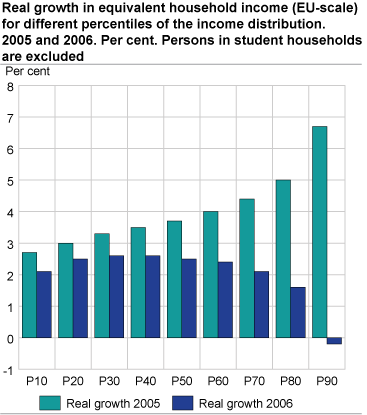Content
Published:
This is an archived release.
More equal income distribution
The distribution of income between different income groups became more equal from 2005 to 2006. The main explanation for this development is a sharp decline in received dividends for high-income households and an increase in wages and salaries, particularly among households with income below the median.
The median equivalent household income rose by 2.5 per cent in fixed prices from 2005 to 2006. This was slightly lower than in the previous year (3.7 per cent).
Whereas high-income households had the strongest increase in income in 2005, households with below the median income had the strongest increase in 2006.
The changes in the income distribution highly reflect changes in tax rules. A less generous taxation of dividends was introduced in 2006 and led to a sharp decline in dividend payout. Because dividends are primarily received by households with high income, this change had an equalising effect on the distribution of income. Another change in 2006 was the improvement in the labour market, which resulted in more people entering the labour force. This led to an increase in the proportion of wages and salaries in the total household income, particularly for households with below the median income.
Tables:
- Table 1 Distribution of household equivalent income after taxes, between persons. (EU-scale). Decile shares and cumulative decile shares. 1986-2006. Per cent
- Table 2 Measures of income despersion. Household equivalent income (EU-scale) between persons. 1986-2006
- Table 3 Composition of total household income within decile groups for household equivalent income after taxes , between persons. (EU-scale). 1990, 1995, 2000 og 2006. Share of total income. Per cent
- Table 4 Percentage of people in households with annual after-tax income per consumption unit below different distances to the median income. OECD-scale and EU-scale. 1996-2006
- Table 5 Low-income thresholds for different types of households (annual income) equal to 50 and 60 per cent of the median income after tax. 2006. NOK
- Table 6 Household equivalent income (EU-scale), for different percentiles of the income distribution. NOK in 2006
The statistics is published with Income and wealth statistics for households.
Contact
-
Statistics Norway's Information Centre
E-mail: informasjon@ssb.no
tel.: (+47) 21 09 46 42

